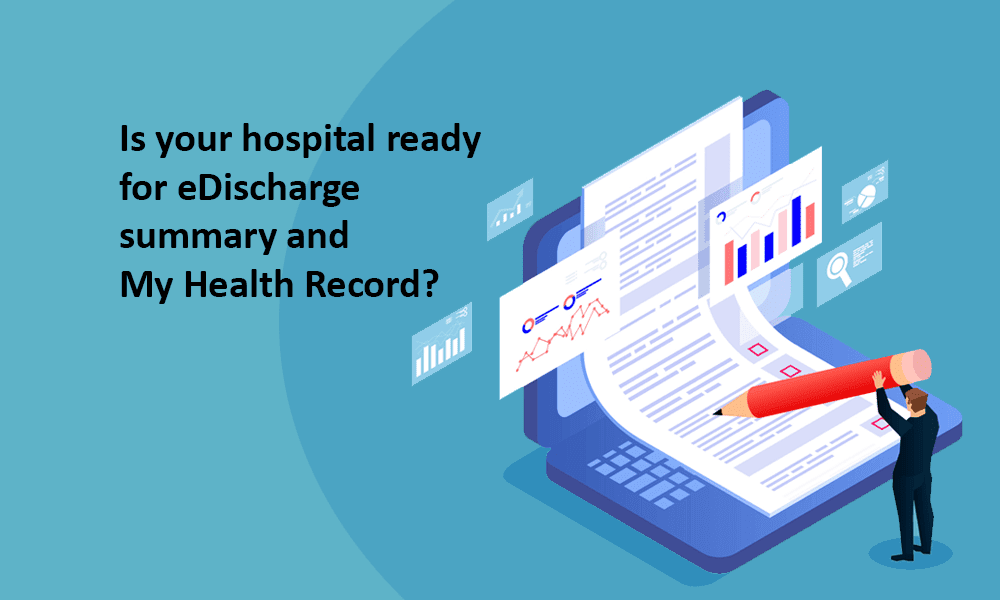Did you know that incompleteness of patients’ discharge summaries shows strong correlations to increased readmission rates to hospital and adverse patient events? This is why accurate and timely completion of Discharge Summary is essential for the patient’s ongoing care. Because it is the primary communication tool for the GP and community.
However, if you are to receive the benefits of well-maintained patient discharge summaries, you don’t have to get your clinician and admin staff to manually work on them. Because eDischarge summary systems are here to transform how you’ve been going about completing patient discharge summaries once and for all. In this article, I share what is an Electronic Discharge summary and 3 keys areas it can improve discharge summary quality in terms of content, timeliness and distribution.
Content: Integrating fragmented episodic data
According to Australian Commission on Safety and Quality in Health Care, a complete discharge summary should contain information on Reasons for hospitalisation, Procedures performed, Care, treatment, and serves provided, Discharge condition, Information provided to the patient/family, Accurate and up-to-date records of patient medications and Attending physician signature.
In most hospitals, a patient’s episodic data is fragmented and housed in a number of systems of records. This includes PAS (patient administration systems), DMR (a digital medical record) or EMR (Electronic Medical Record) systems. Often these systems are database driven and contain only structured patient information. However, 80% of real episodic information is unstructured. Thus, to create an actionable discharge summary you need to consolidate structured, semi-structured and unstructured data and present this information in a meaningful manner.
Therefore, organising all this information manually is time-consuming and error-prone. However, an Electronic Discharge Summary system can help you collect and organise all the data required for the discharge summaries via effective integration in-between systems automating the process.

When integrated with a PAS system, relevant demographic and episodic information can be auto-populated into the discharge template so that double data entry will be minimised.

Built-in voice to text conversion of the eDischarge summary system makes it easy for clinicians to add additional information to make discharge summary completion more efficient.
Timeliness: Complete discharge summary worklists and sign-off workflow
Often staff are put under pressure to compile discharge summary within 48 hours of discharge. This adversely affects the quality and timeliness of discharge summary completion as most of the staff is always busy with direct patient care. Junior doctors often have queries for specialist doctors to gather all the information they need to complete the discharge summary.
Electronic Discharge Summary system provides clinicians with tools to monitor and manage their Discharge Summary completion responsibilities easier than ever before. With configurable “Worklists” and the Review and electronic sign-off feature cum with instant access to data required, the system makes managing discharge summaries process faster and more effective.

These tools provide real-time status reporting of eDischarge summary completion which allows individual clinicians to constantly monitor and manage their discharge summary workload.

It improved access during off-hour periods by virtue of being web-based. It saves our hospital money while meeting a stated goal of improving DSUM completion rates – a key quality metric.
Send Discharge Summary via secure messaging standards

Hospitals and health services are looking at uploading Discharge Summaries to the My Health Record system.
With an eDischarge summary system, you are offered new channels of communication such as secure messaging with national health services directory integration via FHIR- a key technology enabler.
The system also reduces printing paper handling administrative costs and improves clinical and admin staff productivity via automation via Rightfax integration. It also will serve as a wide solution for discharge summary completion, as this facilitates seamless electronic distribution in a standardised format for clinical handover to the GP/Community. When you are using eDischarge summary system to complete Discharge Summaries of patients it ensures you better legibility while facilitating electronic distribution to the GP and my health record.
Summary:
Creating a complete discharge summary and distributing it to the GP and patient portal have shown to improve patient outcomes after a hospital stay, decreasing the chance they’d be readmitted within 30 days. Thus it’s clear discharge summary forms the basis for effective patient care, clinical coding to improve coding accuracy and revenue potential. It helps to tighten the floodgates against coding errors and to improve clinical documentation at the point of care. By integrating electronic discharge summary system into your existing patient discharge process, the process will get faster, more effective and accurate thus ensuring better patient safety and reducing the risks of hospital readmissions. If you are interested in learning more, please contact us for more information.



